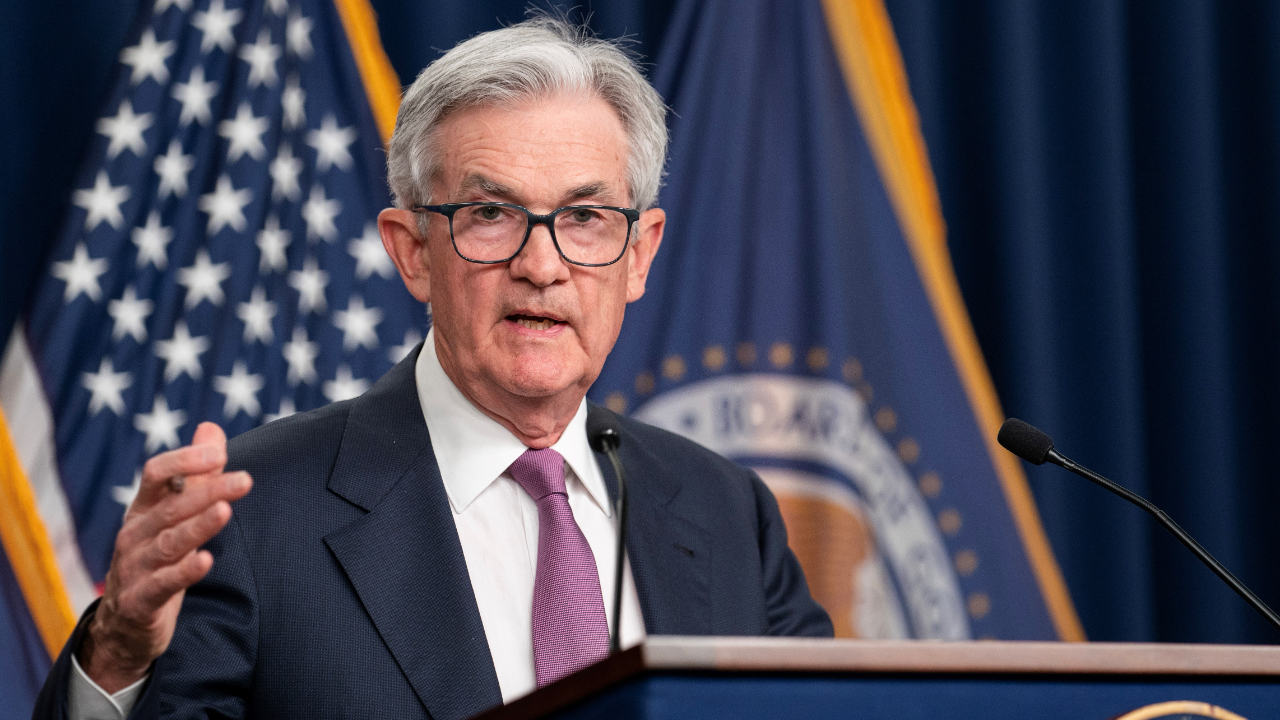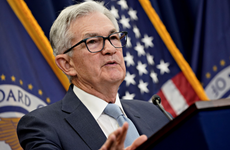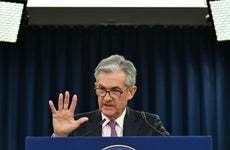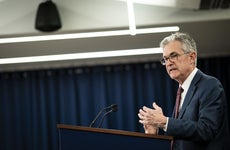Fed hikes interest rates to 22-year high, keeps more increases on the table

The Bankrate promise
At Bankrate we strive to help you make smarter financial decisions. While we adhere to strict , this post may contain references to products from our partners. Here's an explanation for .
The Federal Reserve raised interest rates to the highest level since early 2001 but made no effort to signal that its war against the toughest bout of inflation in four decades is over — even as a growing number of investors and economists look for clues that the end is near.
Officials on the rate-setting Federal Open Market Committee (FOMC) raised interest rates by a quarter of a percentage point, bringing the new target range for their key benchmark interest rate to 5.25-5.5 percent. It marks the 11th total increase since kicking off its new higher-rate era in March 2022 and follows a pause in June.
Rates are now well into the territory that U.S. central bankers assume is tapping the brakes on the economy. Prices last summer were rising three times faster, showing inflation is winding down and some of the Fed’s antidote to higher prices may be working. But some measures of inflation are much more stubborn, particularly inflation in services and housing. That’s largely tied to the resilient job market, which has only modestly slowed since the Fed began raising rates.
The ultimate question, however, is how much more the Fed has to raise rates to bring inflation down. Fed Chair Jerome Powell has described interest rates as nearing their final destination. It’s going to require a new approach to policy, he says, one where officials raise rates at a much slower, more deliberate pace than they were at this time last year — the same way drivers slow down on the interstate the closer they get to their exit.
But with inflation still elevated, the job isn’t over yet. Policymakers will want to see more evidence that inflation is slowing further before backing down. Back in June, the Fed signaled two more rate increases on the table for 2023, and the Fed has now followed through on one of those increases.
Yet, officials also haven’t abandoned their hopes of gently gliding the financial system into a slowdown — a rare feat that has likely started to look like a possibility. The Fed may find that it’s already raised rates high enough, the longer it waits to assess the impact of higher rates. It all suggests that the Fed is committed to not committing.
“The door is open to additional rate hikes, but in true central bank fashion, without an explicit commitment either way,” says Greg McBride, CFA, Bankrate chief financial analyst. “The desired ‘soft-landing’ scenario is within reach, and to a greater extent than previously expected.”
The Fed’s rate hike: What it means for you
Savers
Today’s new world of higher rates has given Americans new money-making opportunities. Back when rates were at record lows in 2020 and 2021, consumers used to have to take on risk to chase even a 5 percent annual return. Today, however, consumers can find those gains on the safest form of investment there is: deposits at a federally-insured bank.
Americans who keep their cash in a high-yield savings account can earn an annual percentage yield (APY) as high as 5.1 percent, according to Bankrate’s latest rankings of the best online banks for July 2023. If you were to deposit $10,000 in one of those accounts, you’d earn $510 in a year, about 10 times higher than what the average bank, based on Bankrate’s national rate survey. And if you’re a customer at one of the nation’s largest banks, such as Chase or Bank of America, you may be able to earn 400-500 times more on your cash.
Another big win: Yields at online banks are higher than the 3 percent annual inflation rate from June, helping preserve your purchasing power as it sits on the sidelines. Of course, Americans experience a different inflation rate than the headline rate, depending on what they buy and where they live. But even excluding the food and energy prices that have been cooling the most, the so-called “core” inflation rate of 4.8 percent in June matches the average rate at Bankrate’s best high-yield savings accounts for July.
With yields this high, you might now consider your high-yield savings account as an investment. Yet, never underestimate the reason why so many Americans should prioritize keeping their cash in an account that’s both liquid, insured and accessible: It’s often the home for their emergency fund. It may seem like the Fed can achieve the impossible — avoiding a recession — but contagions can come out of nowhere. Tougher economies can impact your job security and wage growth, while they may also even lead to increased joblessness. Even economists in Bankrate’s quarterly Economic Indicator poll put the odds of a downturn in the next 12 months at a still-elevated 59 percent.
But if you already have at least six to nine months of cash stashed away for emergencies, consider adding a longer-term certificate of deposit (CD) to your portfolio. The highest-yielding 5-year CDs are still currently paying 4.6 percent a year in interest, helping make sure you can take advantage of this higher-rate era for years to come. Those offers, however, may peak — or even edge lower — once it looks like the Fed’s benchmark interest rate has also hit its ceiling. The average rate on a 2-year CD was offering consumers an APY as high as 5 percent, after offering 5.1 percent just last April, according to Bankrate’s rankings.
Borrowers
Every time the Fed raises rates, it’s like another gut punch to the Americans who are looking to soon borrow money to fund a big-ticket purchase, such as a car or home equity loan.
The stakes are even higher for those who are saddled with variable-rate, high-cost debt. Credit card rates are among the highest levels ever recorded, according to Bankrate’s national survey of issuers. And even home equity lines of credit — once considered a form of low-cost debt — are the highest in 22 years, Bankrate rate data also shows.
Another feature of the higher-rate environment: Lenders are getting stricter about who they approve for a loan. Rejection rates hit the highest in five years for all types of loans, including mortgages, auto loans and credit cards, according to data from the New York Fed. Concentrate on making your monthly payments on time and maintaining a low debt-to-income ratio to keep you eligible for lenders’ best rates.
And even when the Fed eventually does halt its rate increases, lending standards are likely going to remain tight and borrowing costs are bound to stay costly until officials begin cutting rates — moves that aren’t expected until at least 2024, according to Bankrate’s quarterly economists’ forecast. Consider transferring your credit card debt to a balance transfer card with a 0 percent annual percentage rate (APR) introductory offer.
“A zero-percent balance transfer offer can turbocharge the debt repayment efforts,” McBride says. “Even if this proves to be the last Fed interest rate hike, borrowing rates are at multi-decade highs and won’t come down materially just because the Fed moves to the sidelines.”
And don’t panic if you have a fixed-rate loan or pay off your credit card balance in full, you won’t feel any impact when the Fed raises rates.
Homebuyers
Powell spoke about the need for a “reset” in the housing market last June — one where higher rates help slow demand, so home price appreciation can level off. So far, however, the housing market has only grown more difficult for prospective buyers to crack.
The first issue is that the average rate on a 30-year fixed mortgage is now the highest since 2002. That means financing a $500,000 mortgage would cost you $3,326 a month in principal and interest. When rates were at the record-low level of 2.93 percent back in the lows of 2021, that same payment would’ve been $2,089 a month, Bankrate’s calculations show.
And the other main issue is continued low inventory. Americans who were lucky enough to lock in a sub-3 percent mortgage haven’t been quick to trade up for a new rate close to 7 percent.
Builders are starting to pick up the pace to fill demand, but housing starts never caught up to their pre-Great Recession of 2007-2009 peak by the time the coronavirus pandemic began. With housing availability challenges, there’s only a floor on how low prices can go. After declining for seven straight months, housing prices have now increased for the fourth consecutive month, according to S&P Case-Shiller’s Home Price Index for May.
The best time to buy a house is never when the market is telling you to. Often, it comes down to maintaining a low debt-to-income ratio and strong credit score that can help get you qualified for a mortgage. Cash you can use to fund closing costs and a down payment are also crucial.
But if you’re waiting for mortgage rates to return to their pandemic-era lows, don’t bank on it happening anytime soon — unless the U.S. economy faces a major recession, an outcome most economists don’t expect. Be sure to keep an eye on rates and shop around, comparing multiple offers from lenders.
Investors
Investors had long been warned that higher rates could make stocks bumpy. To be sure, that was the main story from 2022. The S&P 500 closed the year down roughly 20 percent, the worst performance for stocks since the 2008 financial crisis.
But investors don’t seem to be fretting about higher rates anymore — likely because the U.S. economy has remained so resilient. The key stock index is now up more than 19 percent since the beginning of 2023 and is down only about 4 percent from its peak.
Those good times aren’t guaranteed to keep rolling on. If the job market ever looks like it’s about to take a turn, stock markets could feel bumpy. Economists in Bankrate’s latest survey see joblessness hitting 4.5 percent by June 2024 and job growth over the next year coming in 11 times slower than the previous 12-month period.
But that shouldn’t matter to the long-term, diversified investor. Tune out the news of the day and stay focused on your longer-term goals. Downdrafts in the market can also be an important buying opportunity, while a diversified portfolio can help you weather any storm in the stock market.
Can the Fed keep raising rates without causing a recession?
In a surprising reveal, Powell said staffers at the Fed who deliver economic updates to policymakers during rate-setting meetings are no longer expecting a recession — at least for this year. Since March, those economists had been projecting that a “mild recession” could kick-start before 2023 ends, with the recovery taking a subsequent two years, according to records of the Fed’s meetings.
That’s likely because the U.S. economy has been outperforming expectations. Job growth has definitively slowed since the blockbuster pace coming out of pandemic-induced lockdowns, but employers haven’t added less than 200,000 jobs in any month since December 2020. Wage growth, meanwhile, has been moderating, but pay is still climbing at a faster pace than before the pandemic — and now, it’s even eclipsing inflation.
“Inflation moving down to target without a significant downturn, without high levels of job losses that we’ve seen in some past instances of tightening, that’s been my view, and that’s still my view,” Powell said. “But it’s a long way from assured, and we have a lot left to go see that happen.”
Powell kept higher rates on the table for later this year and was mum on how soon one could take effect. Making or breaking that likelihood are four crucial data releases. Before the Fed next meets in September, officials will have two new snapshots of the labor market and inflation for July and August.
The higher the Fed raises rates, the higher the risk of a hard-landing becomes.
“The probability of an imminent recession has diminished, but it’s still not zero,” says Sonia Meskin, head of U.S. macro at BNY Mellon Investment Management. “What may have increased in probability is a delay of the landing or a delayed harder landing.”
Powell does expect some softening in the labor market — an outlook that would still be consistent with “softly landing” the economy. But how much of a slowdown is necessary to bring inflation back to officials’ 2 percent objective isn’t clear. Back in the Fed’s June projections, officials penciled in unemployment of about 4.5 percent as a level consistent with near-2 percent inflation.
“We need to stay on task,” Powell said. “We’re going to certainly be holding policy at restrictive levels for some time and be prepared to raise rates further.”
Related Articles

Survey: Inflation could remain stuck above Fed’s 2% target until 2025

Fed raises rates by quarter point, signals more increases on way to further bring down inflation

